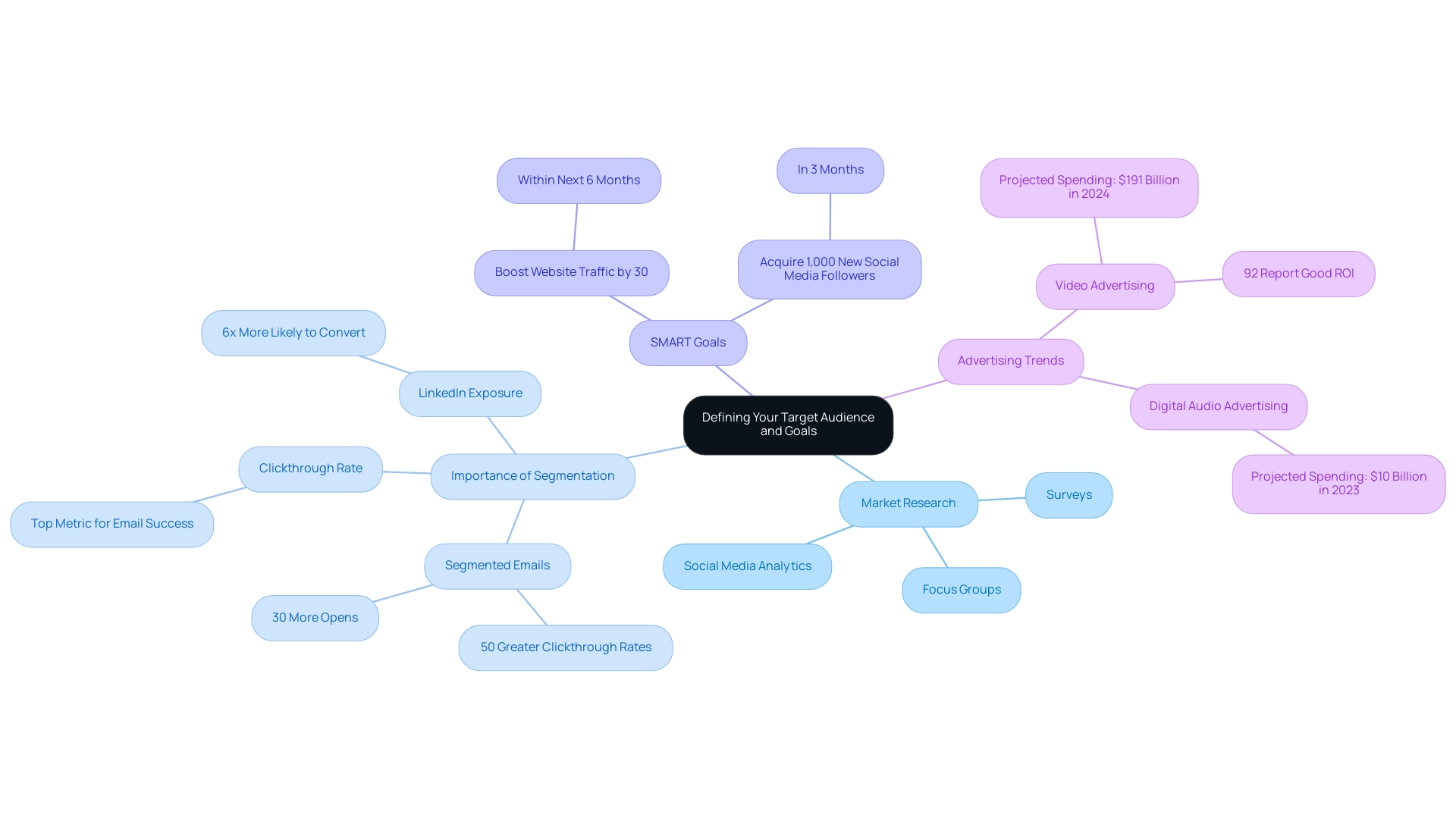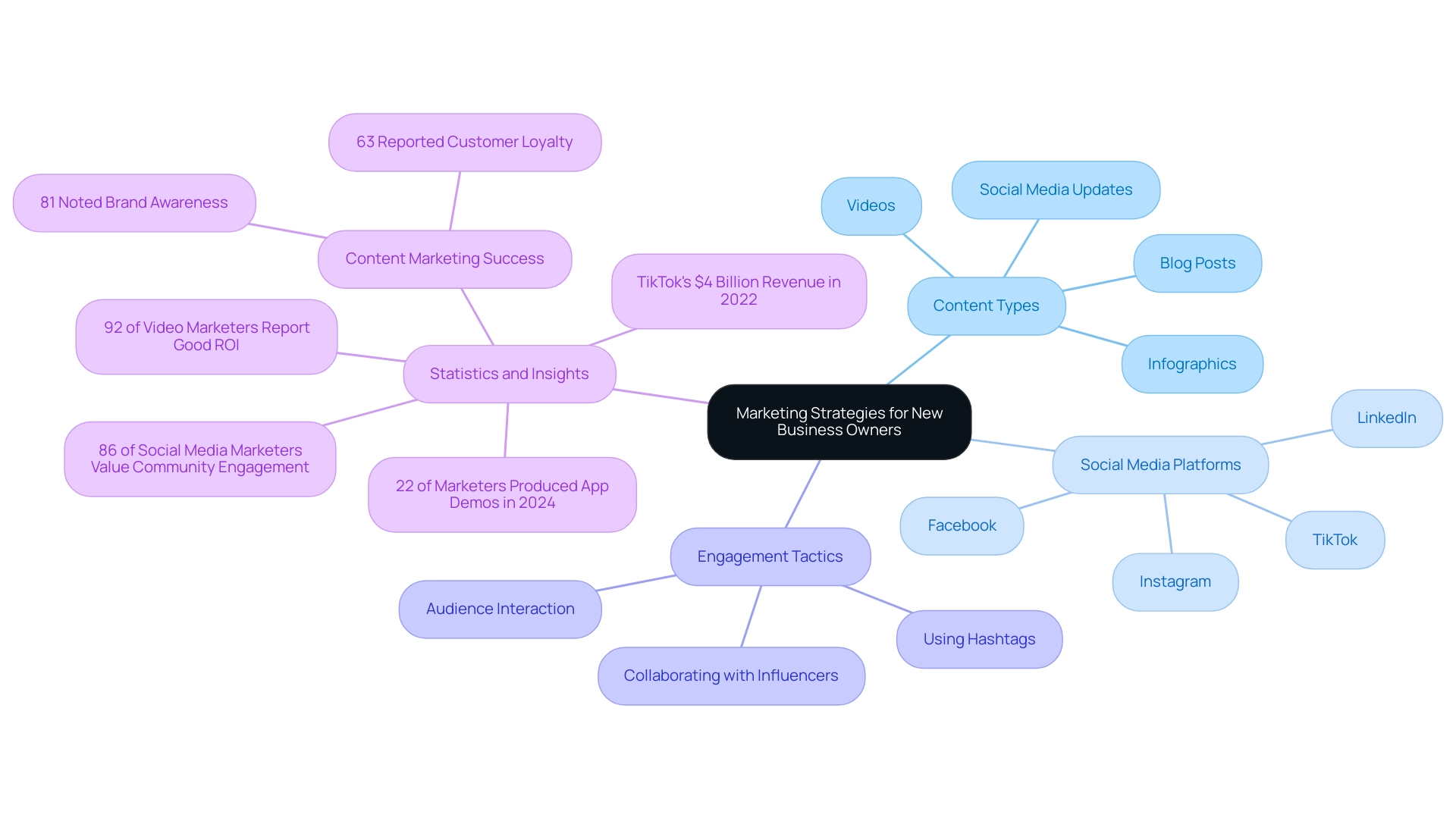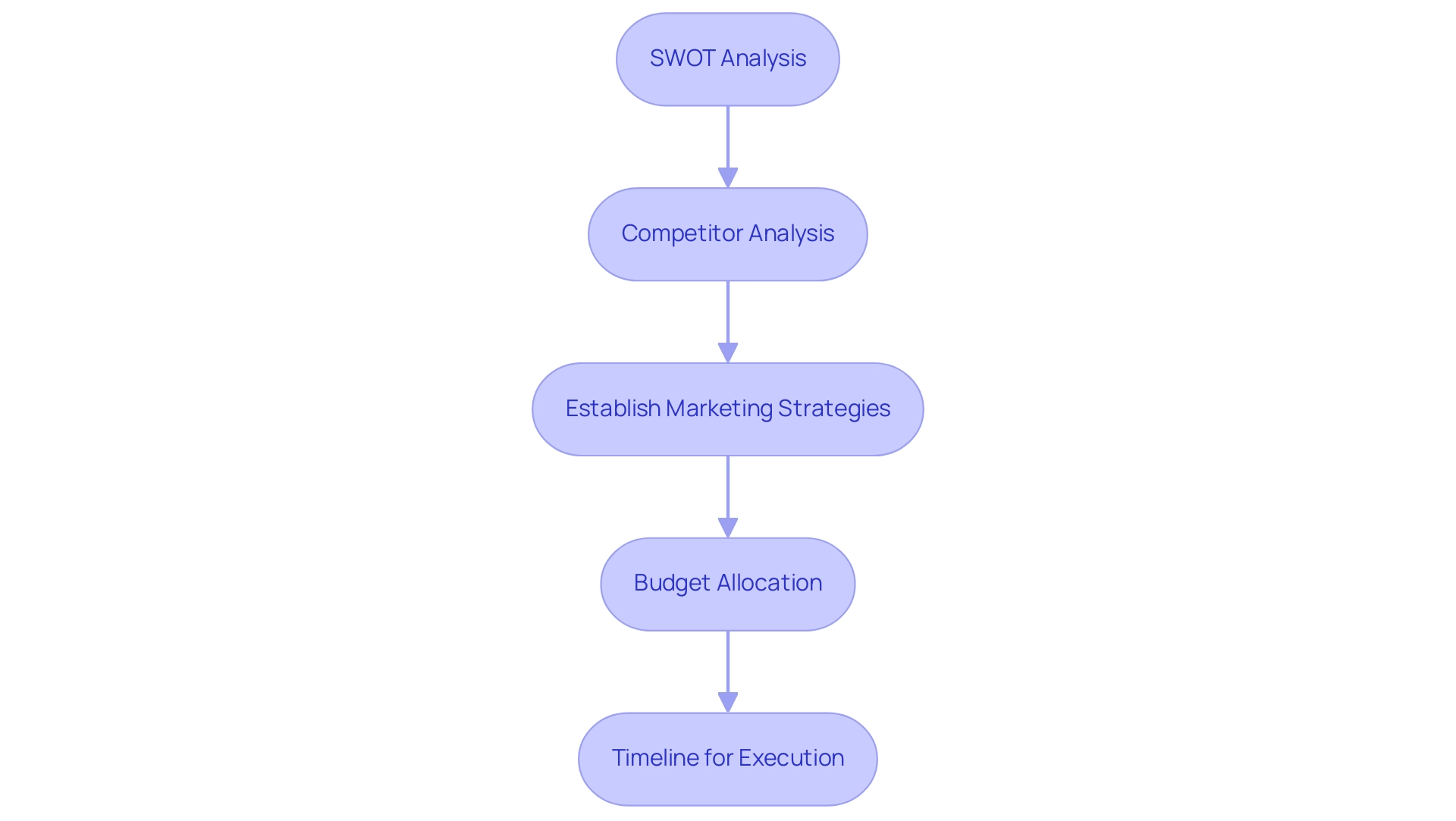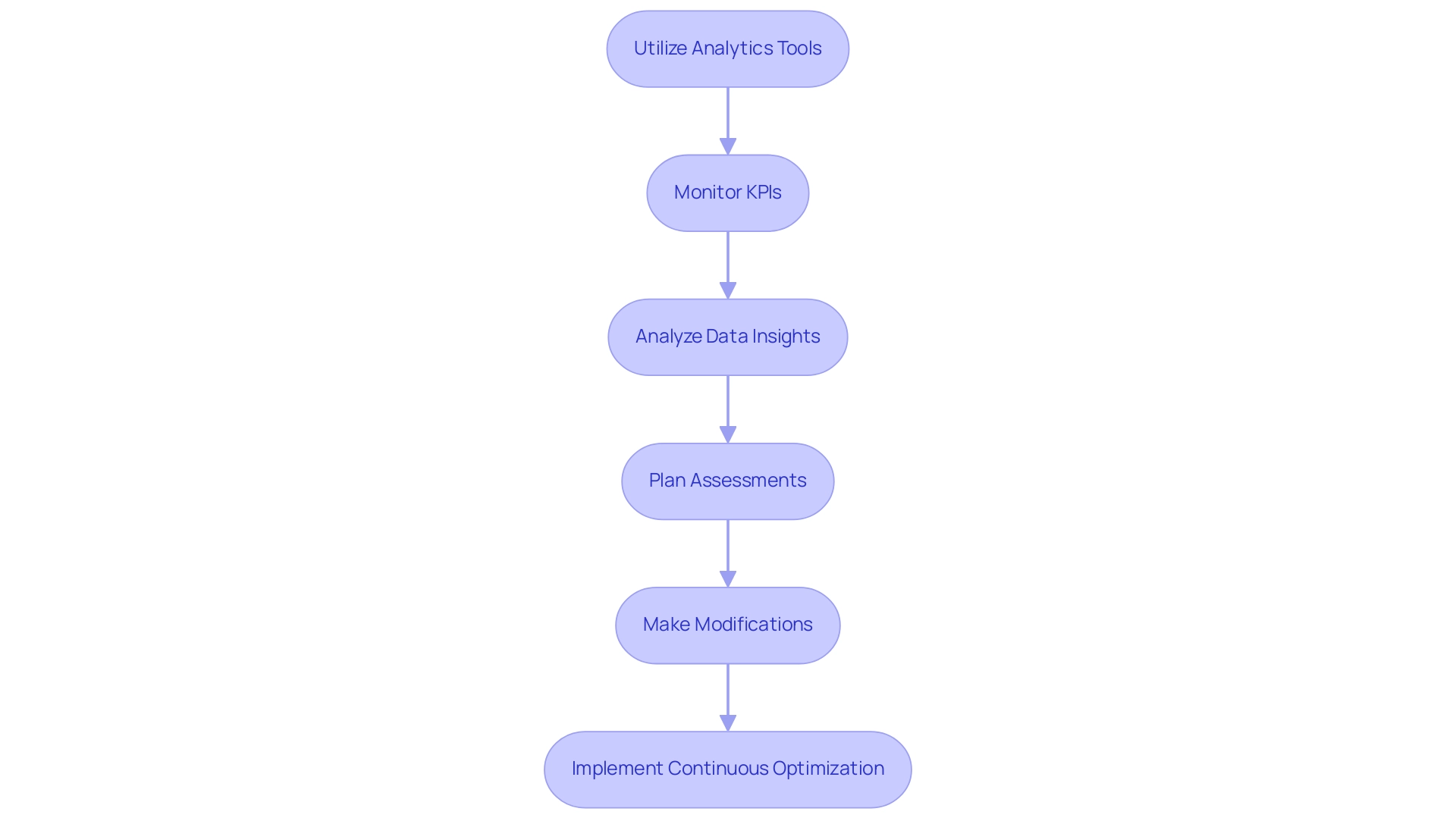Overview
Creating a winning marketing strategy involves defining your target audience, setting SMART goals, leveraging content and social media for engagement, and utilizing analytics to measure success. The article outlines a structured approach that includes market research, competitor analysis, and continuous adaptation to market trends, emphasizing the importance of targeted communication and data-driven decision-making for new business owners.
Introduction
In the competitive landscape of modern marketing, understanding one’s audience and setting clear objectives is paramount for success. Businesses must navigate a myriad of strategies, from leveraging data analytics to crafting engaging content, all while remaining agile in response to market trends.
With the rise of digital platforms, the ability to connect with consumers through targeted communication has never been more critical. This article delves into the essential steps for:
- Defining target audiences
- Crafting effective marketing plans
- Measuring success through data-driven insights
By embracing these practices, organizations can not only enhance their engagement but also position themselves for sustainable growth in an ever-evolving marketplace.
Defining Your Target Audience and Goals
To effectively define your target audience, begin with comprehensive market research that identifies key demographics such as age, gender, income level, and interests. This analysis can be enriched through various methods, including:
- Surveys
- Focus groups
- Social media analytics
All of which help collect vital data. Recent trends indicate that companies leveraging segmented emails see 30% more opens and 50% greater clickthrough rates compared to unsegmented emails, highlighting the power of targeted communication.
Clickthrough rate is the top metric marketers utilize to monitor email success, further emphasizing the importance of segmentation in your approach. Additionally, video advertising is gaining traction, with spending projected to exceed $191 billion in 2024, and 92% of video marketers reporting good ROI, making it a valuable asset for organizations looking to engage their audience effectively. Furthermore, digital audio advertising is expected to surpass $10 billion in 2023, signaling a wider trend towards multimedia promotional approaches.
Once you have a clear understanding of your audience, it’s crucial to establish SMART goals—Specific, Measurable, Achievable, Relevant, and Time-bound. For instance, you might aim to:
- Boost website traffic by 30% within the next six months
- Acquire 1,000 new social media followers in three months
Documenting these goals not only aligns your promotional efforts with your business objectives but also provides a clear roadmap for success.
As highlighted by LinkedIn, exposure to brand messages on their platform makes individuals six times more likely to convert, reinforcing the importance of precise audience targeting in your promotional strategy.

Leveraging Content and Social Media for Engagement
Creating a well-organized schedule is essential for arranging and planning your promotional efforts as outlined in the guide to Marketing strategies for new business owners. This calendar should act as a guide to Marketing strategies for new business owners, outlining the types of material you plan to share and the schedule for their release, including:
- Blog posts
- Infographics
- Videos
- Various social media updates
Using platforms like Facebook, Instagram, and LinkedIn can serve as a valuable guide to Marketing strategies for new business owners, significantly enhancing your ability to reach and engage with your audience.
According to recent insights, 86% of social media marketers believe that a guide to Marketing strategies for new business owners should emphasize the importance of cultivating an active online community for success. Moreover, 22% of advertisers created app demonstrations in 2024, which highlights the increasing trend of interactive material in promotional strategies as a guide to Marketing strategies for new business owners. To enhance your material, consider using a guide to Marketing strategies for new business owners by sharing:
- Valuable industry insights
- Compelling customer testimonials
- Exclusive behind-the-scenes glimpses of your business
Encouraging audience interaction by posing questions and responding swiftly to comments is an essential aspect highlighted in the guide to Marketing strategies for new business owners, fostering a two-way dialogue. Incorporating trending hashtags and utilizing the guide to Marketing strategies for new business owners by collaborating with influencers can further amplify your reach. Significantly, the video platform TikTok generated $4 billion in advertising revenue in 2022, and its revenue is anticipated to double by 2024, illustrating the potential of video promotion.
Furthermore, a case study titled “Success of Content Promotion” reveals that:
- 63% of content creators report that content promotion has helped build customer loyalty
- 81% note it has created brand awareness
Ultimately, the aim is to provide genuine value to your audience while nurturing a vibrant community around your brand, which can serve as a guide to Marketing strategies for new business owners.

Crafting Your Marketing Plan: Steps to Success
To initiate your promotional plan, start with a thorough SWOT analysis (Strengths, Weaknesses, Opportunities, Threats) as part of your guide to Marketing strategies for new business owners to evaluate your organization’s current standing. This foundational step allows you to identify what sets you apart in the market and where you may need improvement. As the ever-relevant quote suggests,
Continuous monitoring and adaptation of your SWOT analysis is essential for maintaining a competitive advantage in today’s dynamic business environment.
Following this, conduct a thorough competitor analysis to understand their marketing approaches, pinpointing gaps that your startup can exploit. Utilizing statistical analysis, predictive modeling, and data visualization—given that visuals are processed 60,000 times faster than text—can help transform raw data into actionable insights, enhancing your SWOT analysis process. Next, establish a robust guide to Marketing strategies for new business owners that outlines your messaging, the communication channels you’ll utilize, and the frequency of your outreach.
It’s crucial to allocate your budget wisely, accounting for expenses related to advertising, content creation, and necessary tools for execution. For instance, consider the case of Elena, whose project titled ‘Opportunities Exploration’ involved a market trend analysis that revealed a rising demand for sustainable retail spaces and renovation services for restaurants. This insight allowed her to align her services with market needs while addressing her weaknesses, paving the way for potential geographic expansion and new offerings, ultimately enhancing her business’s competitive positioning.
Lastly, outline a timeline for executing your promotional plan, ensuring that each step is actionable and measurable. By adhering to this organized method, you will be better prepared to remain focused and adjust your promotional plans as needed, which serves as a guide to Marketing strategies for new business owners, positioning your startup for success.

Measuring Success: Analyzing and Optimizing Your Strategy
To effectively harness the power of analytics in your promotional approach, it’s essential to utilize tools such as Google Analytics, social media insights, and email campaign metrics. These platforms can help you monitor key performance indicators (KPIs) including conversion rates, engagement levels, and return on investment (ROI). The LTV to CAC ratio, ideally benchmarked at 4:1, serves as a critical KPI for understanding customer profitability.
As Evan Bailyn, a best-selling author and expert in SEO, points out,
Analyzing KPIs is half art and half science, and they won’t necessarily provide you with the most accurate picture without in-house experience in analyzing these metrics.
Consistently plan assessments of your promotional approach to determine what is working well and what needs modification. This willingness to pivot—whether by refining your content strategy, reallocating your budget, or exploring new channels—is vital for sustained success.
For instance, utilizing automated reporting tools such as SEMrush’s My Reports can significantly simplify the process of tracking and visualizing multiple KPIs across various promotional channels. By utilizing these tools, companies can save time and enhance their ability to identify promotional opportunities and challenges, ultimately leading to improved decision-making. Additionally, in 2024, businesses are increasingly focusing on integrating advanced analytics tools to stay competitive, with recent statistics showing that 70% of marketers are prioritizing data-driven decision-making.
By embracing continuous optimization and leveraging the latest trends in analytics, you position your startup for long-term growth and adaptability in an ever-evolving marketplace. Furthermore, it is crucial to activate a preloader class when the preloader is running to ensure a smooth user experience on your digital platforms.

Staying Ahead: Adapting to Market Trends and Changes
To navigate the ever-evolving landscape of promotion, utilizing a guide to Marketing strategies for new business owners is essential, along with remaining engaged with industry developments through reputable sources such as blogs, webinars, and networking events. As the online retail sector exceeded $1 trillion in sales by the end of 2024, staying informed is not just beneficial—it’s critical. Furthermore, total search ad spend is projected to reach $132 billion in 2024, and global digital ad spend is expected to grow from $485 billion in 2023 to $526 billion by the end of 2024.
Consistently assess how your rivals are adjusting to these market changes; their approaches can offer valuable insights. Embrace experimentation with new marketing techniques and platforms, particularly as emerging social media channels gain traction. As noted by industry experts, implementing Generative Engine Optimization (GEO) approaches can enhance visibility in AI-generated search results, leading to better search rankings.
This illustrates the potential of innovative advertising methods in increasing your brand’s reach. Additionally, consider the diverse content approaches that B2B marketers utilize, including:
- Articles
- Case studies
- Videos
- E-books
to engage your audience effectively. The case study titled ‘Size of the Online Advertising Industry’ emphasizes the growing investment in online advertising as a crucial element of promotional approaches.
Furthermore, actively solicit feedback from your customers to grasp their evolving needs and preferences. By being proactive and adaptable, you position your business to thrive amid dynamic market conditions, making your guide to Marketing strategies for new business owners not only relevant but also effective.

Conclusion
Understanding your target audience and establishing clear marketing objectives are foundational steps in navigating the complexities of the modern marketing landscape. By employing comprehensive market research and utilizing data analytics, businesses can define their audiences more accurately, leading to more effective communication strategies that resonate with potential customers. The importance of segmentation cannot be overstated, as it drives engagement and enhances conversion rates, ultimately positioning companies for success.
Crafting a well-structured marketing plan is equally vital. This plan should encompass:
- A robust content strategy
- A thorough analysis of competitors
- A carefully allocated budget
By setting SMART goals and continuously monitoring progress through key performance indicators, organizations can adapt to market changes and optimize their strategies for sustained growth.
Moreover, leveraging content and social media effectively fosters engagement and community building around a brand. Incorporating diverse content formats and encouraging audience interaction are essential for creating a vibrant online presence. As trends shift and new platforms emerge, staying informed and adaptable will empower businesses to respond proactively to market dynamics.
In conclusion, the integration of audience understanding, strategic planning, and continuous measurement forms the backbone of a successful marketing strategy. By embracing these practices, organizations can not only enhance their engagement but also secure a competitive advantage in an ever-evolving marketplace. The future of marketing lies in the ability to adapt, innovate, and deliver genuine value to consumers, ensuring long-term growth and relevance.


